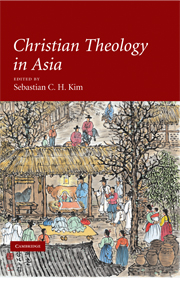Book contents
- Frontmatter
- Contents
- Contributors
- Preface and Acknowledgements
- 1 FORMATION OF CHRISTIAN THEOLOGIES IN ASIA
- II THEOLOGICAL THEMES OF CHRISTIANITY IN ASIA
- 8 Religious pluralism, dialogue and Asian Christian responses
- 9 Cross-textual hermeneutics and identity in multi-scriptural Asia
- 10 Re-constructing Asian feminist theology: toward a glocal feminist theology in an era of neo-Empire(s)
- 11 The ecumenical movement in Asia in the context of Asian socio-political realities
- 12 Mission and evangelism: evangelical and pentecostal theologies in Asia
- 13 Subalterns, identity politics and Christian theology in India
- Index
- References
12 - Mission and evangelism: evangelical and pentecostal theologies in Asia
Published online by Cambridge University Press: 05 June 2012
- Frontmatter
- Contents
- Contributors
- Preface and Acknowledgements
- 1 FORMATION OF CHRISTIAN THEOLOGIES IN ASIA
- II THEOLOGICAL THEMES OF CHRISTIANITY IN ASIA
- 8 Religious pluralism, dialogue and Asian Christian responses
- 9 Cross-textual hermeneutics and identity in multi-scriptural Asia
- 10 Re-constructing Asian feminist theology: toward a glocal feminist theology in an era of neo-Empire(s)
- 11 The ecumenical movement in Asia in the context of Asian socio-political realities
- 12 Mission and evangelism: evangelical and pentecostal theologies in Asia
- 13 Subalterns, identity politics and Christian theology in India
- Index
- References
Summary
The church in Asia has been growing at a phenomenal rate, doubling twice in the last century. This chapter will first examine the beginnings of evangelical and pentecostal theologies up to the middle of the twentieth century; secondly their further developments over the last fifty years; and thirdly the challenges posed for understanding Christianity and mission in Asia and globally.
First we need to clarify our use of the terms evangelical and pentecostal. ‘Evangelical’ refers to those who are theologically conservative, subscribing to traditional Christian doctrines and affirming the ultimate authority of the Bible, the importance of personal conversion and the need to obey the Great Commission of Matthew 28:18–20. ‘Pentecostal’ is used in a broad sense to refer to all who emphasize the supernatural work of the Holy Spirit and take seriously ‘signs and wonders’ in the life and ministry of the Christian church; hence, it applies collectively to ‘classical Pentecostals’ and ‘charismatics’ who trace their roots to Azusa Street in 1906, as well as to many varieties of indigenous Asian churches.
THE NINETEENTH CENTURY AND THE FIRST HALF OF THE TWENTIETH CENTURY
India
Nehemiah Goreh (1825–95) is an important example of evangelical theology in nineteenth-century India. Goreh was a Brahmin who converted to Christianity in 1848. His most significant work, A Rational Refutation of the Hindu Philosophical Systems, is a conscious apologetic directed at the six traditional systems of Hindu philosophy, including a lengthy critique of Advaita Vedanta (non-dualism).
- Type
- Chapter
- Information
- Christian Theology in Asia , pp. 250 - 270Publisher: Cambridge University PressPrint publication year: 2008

